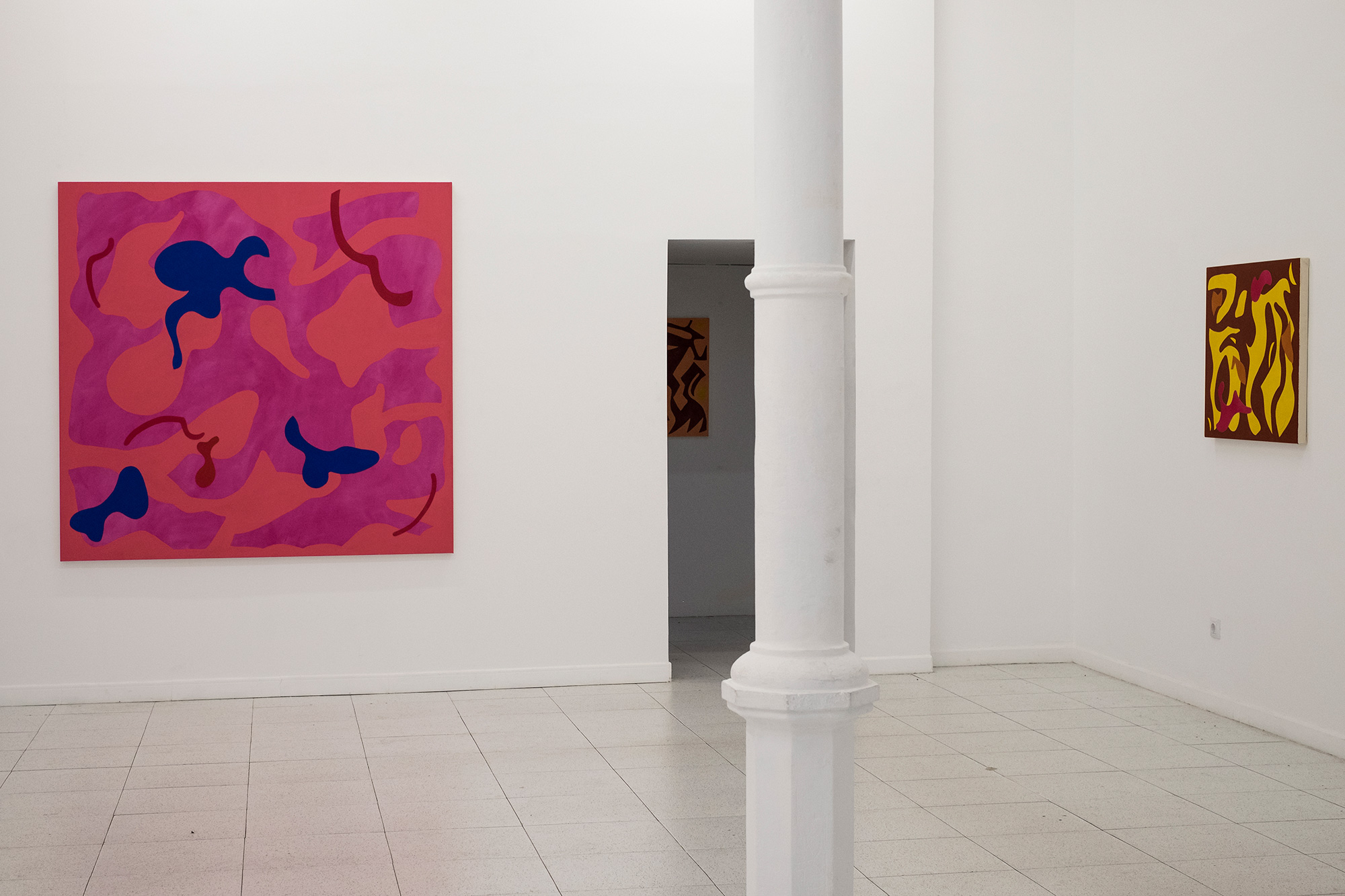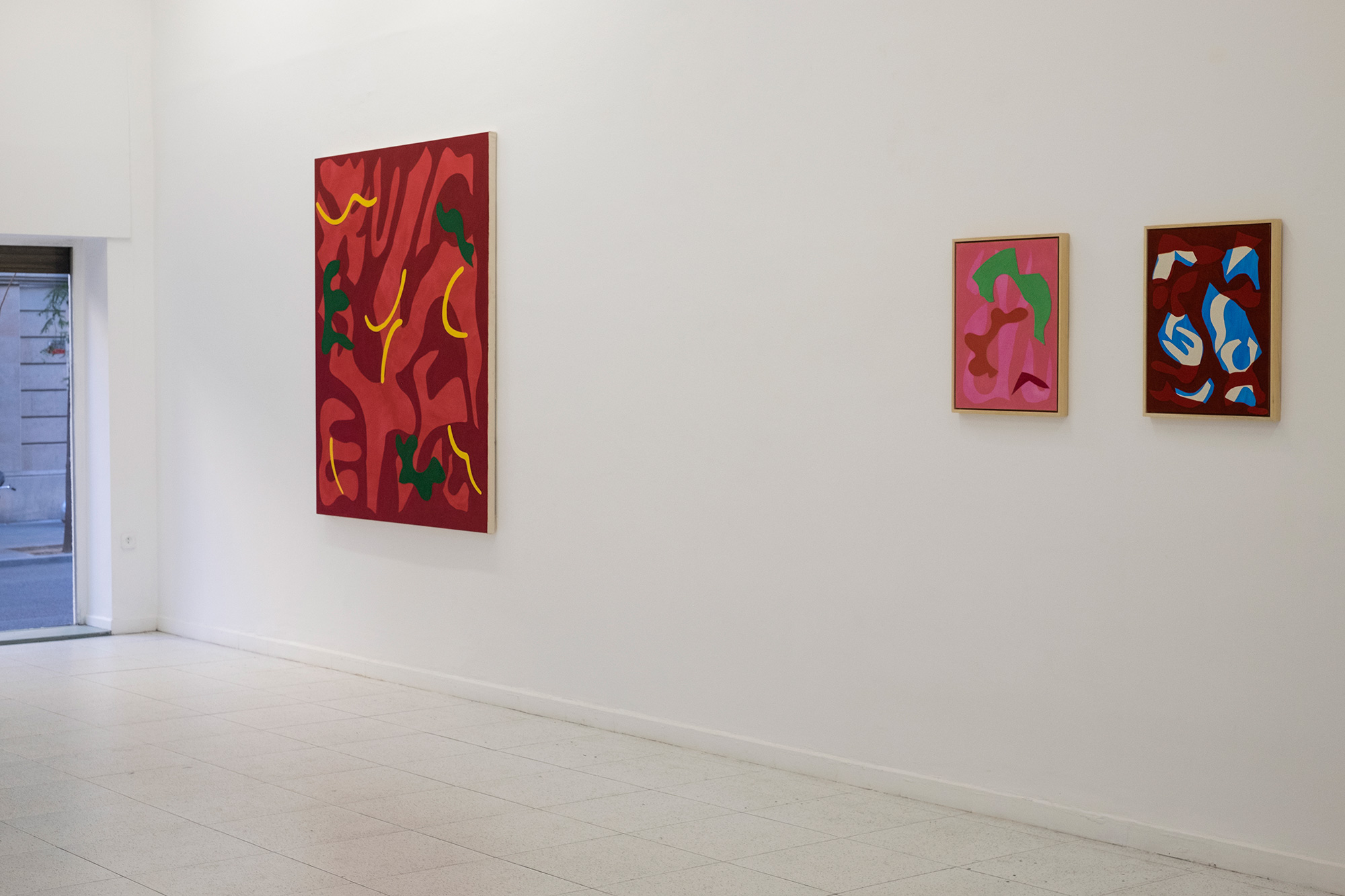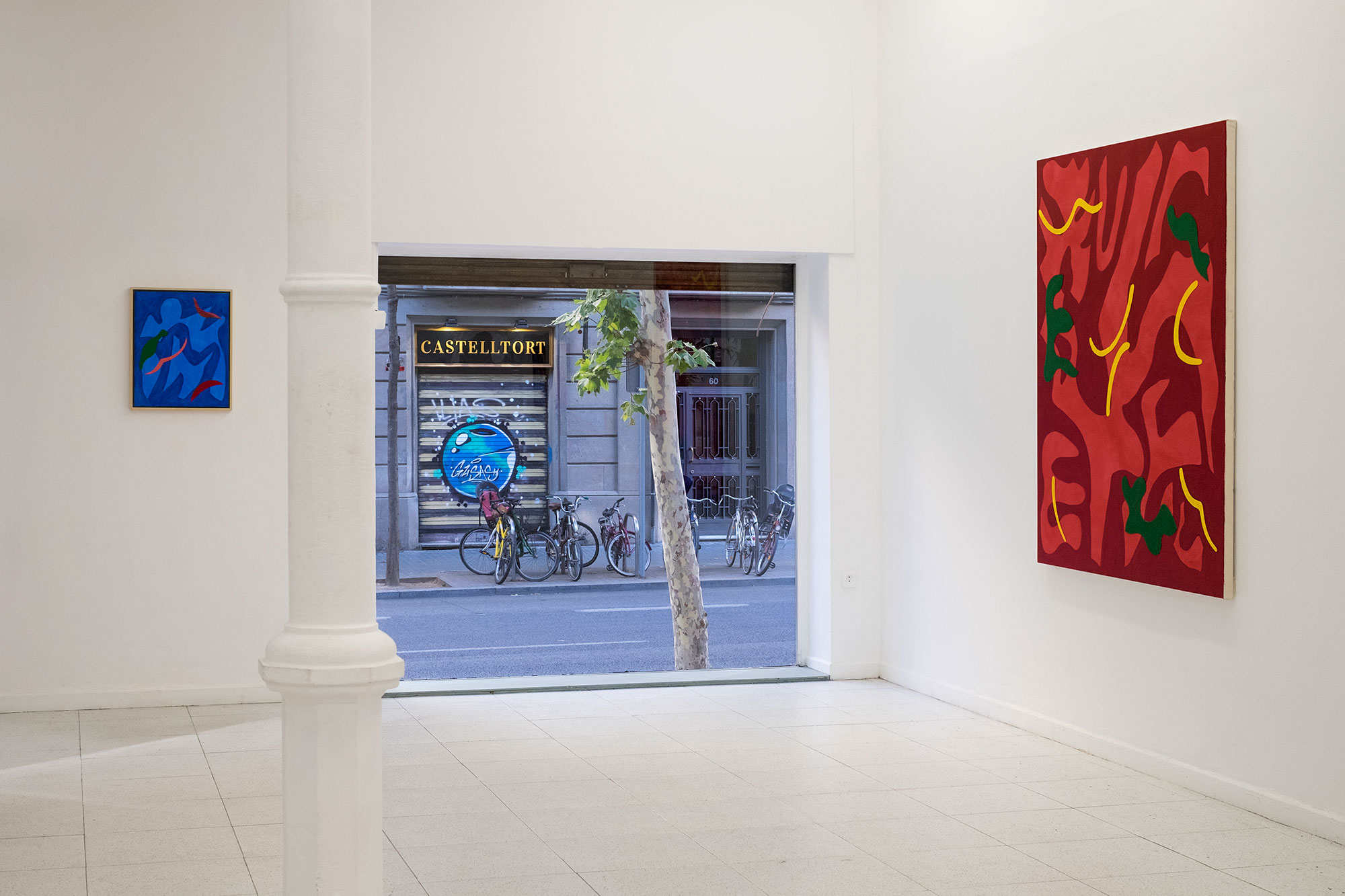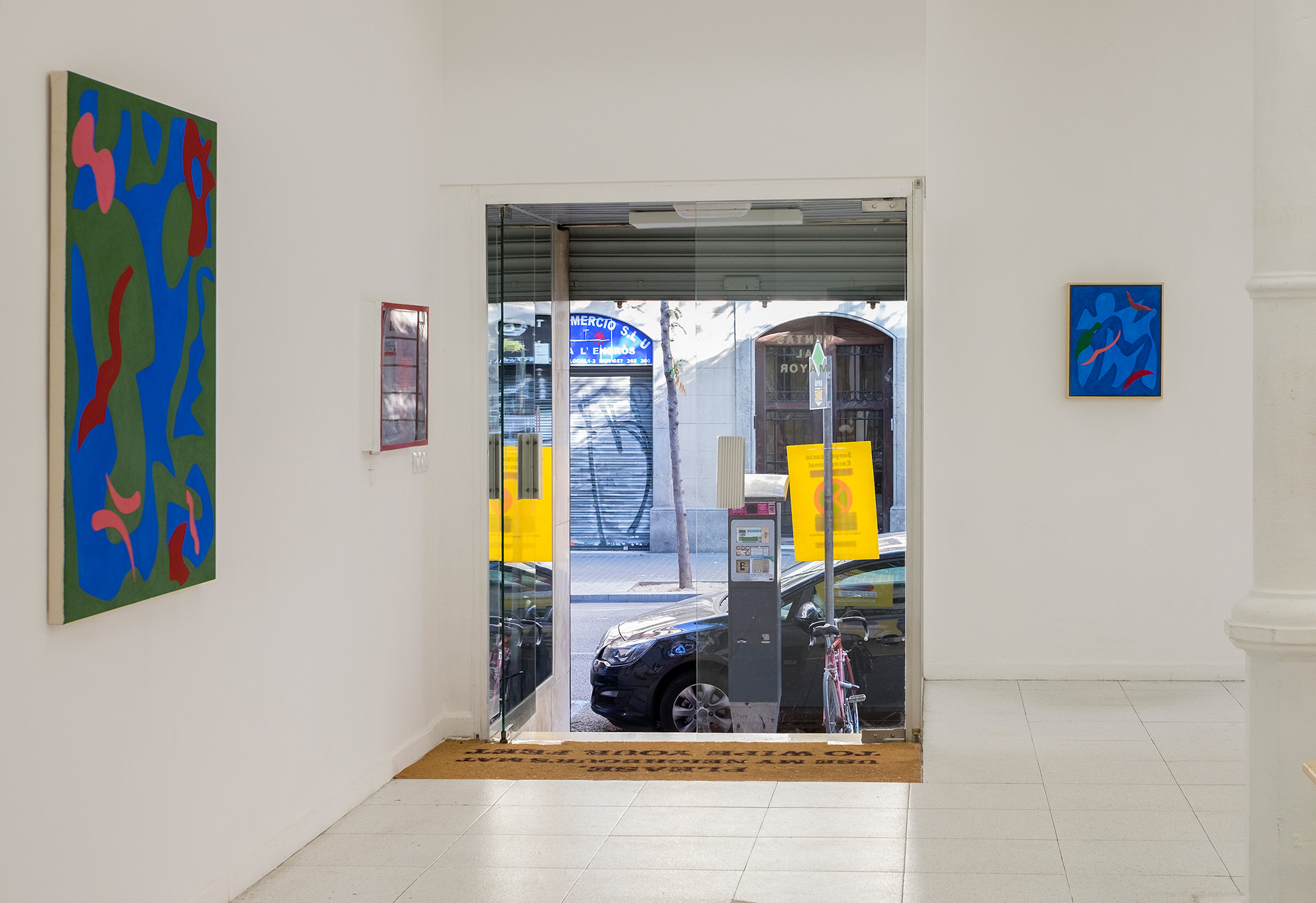22 June – 28 July 2017
Barcelona






THE ZOO
Text by Michael Lawton (curator of the exhibition)
A buttock-faced quadruped mewled in its cage.
I looked over as it performed small circles in the centre of the space, before settling down to sleep in the shadow of the fluorescent cacti that fringed its quarters.
The zookeeper hadn’t taken his eyes from the board to observe what I assumed was a nightly performance. I looked at him; the blue-white light of the heat lamps reflected off his glasses.
Eventually he made his first move, as always he started from the corner, setting the sequence of his strategy, the dance across the board, inexorably in motion.
Leaves had fallen through the roof of the umbraculo and were flat on the ground at our feet. Though it was night it was warm enough for us to be in this space, simultaneously interior and exterior. The overlapping shapes of the fallen leaves were organic but unfamiliar, like every living thing that surrounded me, every living thing except for the zookeeper that is, who was waiting for me to make my move.
A pink-skin-coloured plant had furled itself along the structure overhead. Its meaty tendrils were so thick and sinewy that I felt I could hear it creak, growing above me in real time. Not for the first time I thought that this was a tactic on the part of the zookeeper to put me off my game, likewise the one-eyed birds that roosted along this fleshy tapestry seemed only to crow during my turn.
As always I started from the centre, wanting a point from which I could return and refer to.
As it was night he had locked us in as packs of wild dogs wandered outside wanting ingress, waiting to rip the zoo animals into more familiar shapes with their teeth. We were closed off within the space, like the pieces within the game.
As we played I thought about painting.
As we played I talked about books.
I told him I had just read ‘The Master of Go’ by Yasunari Kawabata. Apparently it was the author’s favourite of all of his works. Like all of those of his that I have read it is seemingly constructed about descriptions of nature, of tangerine groves and lawns and grass and soft and sweet air. Though the book is ostensibly assembled around an epic game of Go, I wondered if it wasn’t in fact the seasons that shape this and all of his stories.
The serene natural world of Kawabata had little in common with the abnatural shapes that surrounded me; the yellow “creeper-feeders” as the Zookeeper called them, canary-coloured caterpillars I could hear scream as they were eviscerated by the carnivorous vines. These were different spaces of different natures.
Implicit in these descriptions of the natural, and in the seasonal, is the passage of time. Time, or the depiction thereof, is a famous adversary of painting: Painting is an art of space, whereas literature is an art of time. So which is better for depicting a game? The one that shows the board, or the one that retells the moves. The Master Of Go contains some illustrations, just after a move has been played, a game shown in static abstract form. Is time better represented in abstraction?
And I am not sure that we enter the space of a painting, no matter how realistic, we no longer see the world as a churchgoer during the Renaissance, gasping when we realise the adjacent nave is actually a painting. In fact the paintings I like most deny me that space entirely, return my gaze unwaveringly and inscrutably, push me back into my mind and the worlds I find there.
I asked the zookeeper what he thought,
“Maybe playing a game with someone is the best way to describe space to that person? As two people can occupy it, even something as simple as a grid drawn on paper. Whereas with a painting the viewer and the artist take turns in front of it, and with a book the writer and reader commune at distance.”
During the game the zookeeper also told me that when he played he thought about missed opportunities, lost moments within the game and without. When a different move might have been taken, a different game unraveled, a different life lived, a different time.
The possibilities were endless, this is what we wanted from the game, and this is what terrified me about the game.
“Marry, and you will regret it; don’t marry, you will also regret it; marry or don’t marry, you will regret it either way. Laugh at the world’s foolishness, you will regret it; weep over it, you will regret that too; laugh at the world’s foolishness or weep over it, you will regret both.”
“Apparently there are more possibilities in Go than there are atoms in the visible universe,” the zookeeper told me with a rueful smile.
“I sometimes wonder if this is a space I am perhaps scared of leaving,” he said, sweeping his hand over the board regally. I looked at him, he wasn’t looking at me as he spoke, instead the two trapezoids of his spectacles were fixed on our game.
The zoo wasn’t a space one got used to and I could never resist looking about me whilst waiting for my turn, at the claws molted by the apes the keeper had bred, sitting gnarled and chewy on the footpath I took to the toilet.
“The hand remembers the moves it has made,”
He said, as if he knew what it was I was looking at,
“You mean?”
“That even if I forget the moves I have made, my hand doesn’t, it knows when to retrace its steps. It knows when to take a new path, I don’t commit strategy to memory, my hands remember. I guess painting is like that for you?”
“Have you done any painting today?” he asked me whilst I was still considering the appropriateness of the simile.
I tilted my head to the left, in an ‘if-that’s-what-you-want-to-call-it-then-yes’ gesture. He nodded,
“Painting is slow, the game is slow.”
Like beginning any game when you begin a painting all options are open to you but every mark you make limits you, defines the next mark you might make, wherever on the canvas you might start. That is why we keep playing the game, to try and exhaust every opportunity, that is why we keep painting, to try and paint every picture.
He told me he was reading ‘The Leopard’, an animal not contained within his zoo.
Read More